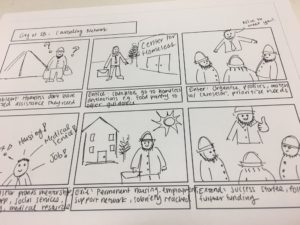City of South Bend:
Our Ideation Summary focuses in on 3 potential solutions for preventing/eradicating chronic homelessness in South Bend using the “5E” framework.
- Hire social worker as a counselor in charge of three chronically homeless individuals
Entice: Develop a counselling program and market it to social workers around South Bend. Additionally, begin to stir interest amongst the homeless population by making them aware of the benefits associated with having a counselor.
Enter: Start with at least 10 social workers. Train them on how to effectively work with the homeless population (i.e. attitude, motivation, behavior, drug issues, mental stability, etc.). Begin to introduce them to key figures at hospitals, social service providers, center for the homeless, soup kitchens across town, employers, landlords, and many other influential figures that the homeless people need to interact with on a daily/weekly/monthly basis.
Engage: The counselors would provide mentorship, access to drug and mental illness counselling, employment opportunities, resume reviews, increased access to social service resources, access to food via soup kitchens, their personal network, personal experience, access to temporary and permanent housing. They would help homeless population begin to develop a social network, hopefully giving them the means for advancement.
Exit: Counselors could make weekly visits/checkups after their assigned homeless individual is in permanent housing to make sure they are still clean from drugs, mentally stable, and still employed/attending work.
Extend: Staying in touch with the homeless individuals (hopefully now fully independent/not homeless) and utilizing them to help the current homeless population with their problems. Continuing to grow the network and have people sharing their experiences.
Key Takeaway: Homeless individuals are in need of a support network to get themselves out of their situation. Without developing support relationships, it is difficult for them to receive the motivation and support overcome their homelessness situation.
- Shared living to help develop a network. Develop subsidization program.
Entice: Spread awareness to homeless people by means of their counselors. Attract the homeless population by informing them of a way to live more independently, while having a support network of similar individuals. Low cost, non-discriminatory, and provides address for social security purposes.
Enter: Allocate resources and funding to apartment buildings or houses in South Bend that can be turned into communal living homes. Create a specific program with regulations (ex: drug tests, job requirements?) that allow 4 or more homeless people to live together in government subsidized housing.
Engage: The housing would lift a burden off the residents’ shoulders, so that they can spend more of their time toward finding a stable job, paying for food, paying off other bills or loans, etc. The residents would have their own rooms to ensure individual privacy and independence, but would share other areas like the kitchen and living rooms, thus strengthening the support system between them.
Exit: After the residents establish a stable income and can support themselves, connect them with local landlords who can provide low-income housing. The residents would eventually move into their own private apartment and live on their own.
Extend: Maintaining close relationships with former housemates and building new relationships to expand each individual’s support network. With greater support, homeless individuals and people in danger of becoming homeless can reach out for help and advice.
Key Takeaway: Establish a support system that homeless individuals feel they can connect with on a personal level. These individuals have gone through similar experiences and can empathize with each other.
- Hire homeless to deliver food via bike.
Entice: Create corporate partnerships with food delivery companies such as Grub Hub, Dine In, Uber eats,etc. and create a program in which homeless people could deliver the food via bikes owned by the company for a small fee, and consumers would have the option to purchase a meal for the homeless person as well (BOGO model). This would be a good PR opportunity for companies, and provide jobs and meals to the homeless.
Enter: Counselors would connect members of the homeless population with this program, and the City of South Bend would create incentives for corporations to participate (tax credits, financial incentives, etc.).
Engage: The partnership would give homeless people a source of part-time work, while also providing some food and building work experience. Biking to deliver the food ensures that users do not need a license, and it is a type of work that most people could participate in.
Exit: The users would establish a steady source of income and begin building a professional network. Hopefully, they could get a full-time job after this position.
Extend: Eventually, the homeless individuals could use this network to find full-time work and establish more contacts in the professional world. They could also spread the word to other individuals in the community who may be looking for a low-skill requirement job with a flexible work schedule.
Key Takeaway: Finding a source of simple, and relatively easy work could go a long way for these individuals if the company is willing to hire them.
- Create database with information of all chronically homeless individuals in South Bend. Without defining the population, it will be difficult to create an effective solution.
Entice: Understanding the profiles of chronically homeless individuals is the first step to designing and implementing a comprehensive solution to this issue in South Bend. We must first gain insight into exactly how many homeless people are within our range, and also learn more about their individual needs so that resources can be allocated more efficiently. The homeless offer their information to be collected in order to access personalized solutions.
Enter: This information will be individually updated through personal accounts, or gathered from individual interviews and consulting sessions. Additionally, it is important to gain insight into the individual’s life from another person’s perspective, a person that he or she might frequently interact with, to get the full picture of the individual and an unbiased story.
Engage: This database will include biographical information such as a basic description of their appearance (height and weight) and other unique characteristics that would separate them apart. It also will include the individual’s “story”, along with a list of prioritized needs that the individual and the interviewer have conversed about. Lastly, a picture of the individual will be included for future identification purposes, if needed. This information will be uploaded to the cloud where counselors and city officials can access the data without having to re-mine for it.
Exit: When an individual has successfully entered into permanent housing, he or she will be moved to a section on the database separate from the biographies of current homeless people.
Extend: It is important to maintain a relationship with all of these individuals in order to track progress on their recovery and integration back into the real world. Also these biographies with the permission of individuals, can be shown as examples of how to move out of homelessness or of how to prevent it from happening. These stories can be uploaded to a blog so people can ask questions and so it can be easily accessible.
Key Takeaway: Identifying homeless individuals and gaining a more detailed understanding of who they are and what they might need in a timely manner is a small step towards further organization of the homeless assistance system. In addition having their stories can help the city understand the nature of homelessness and how to better deploy resources into the future.



